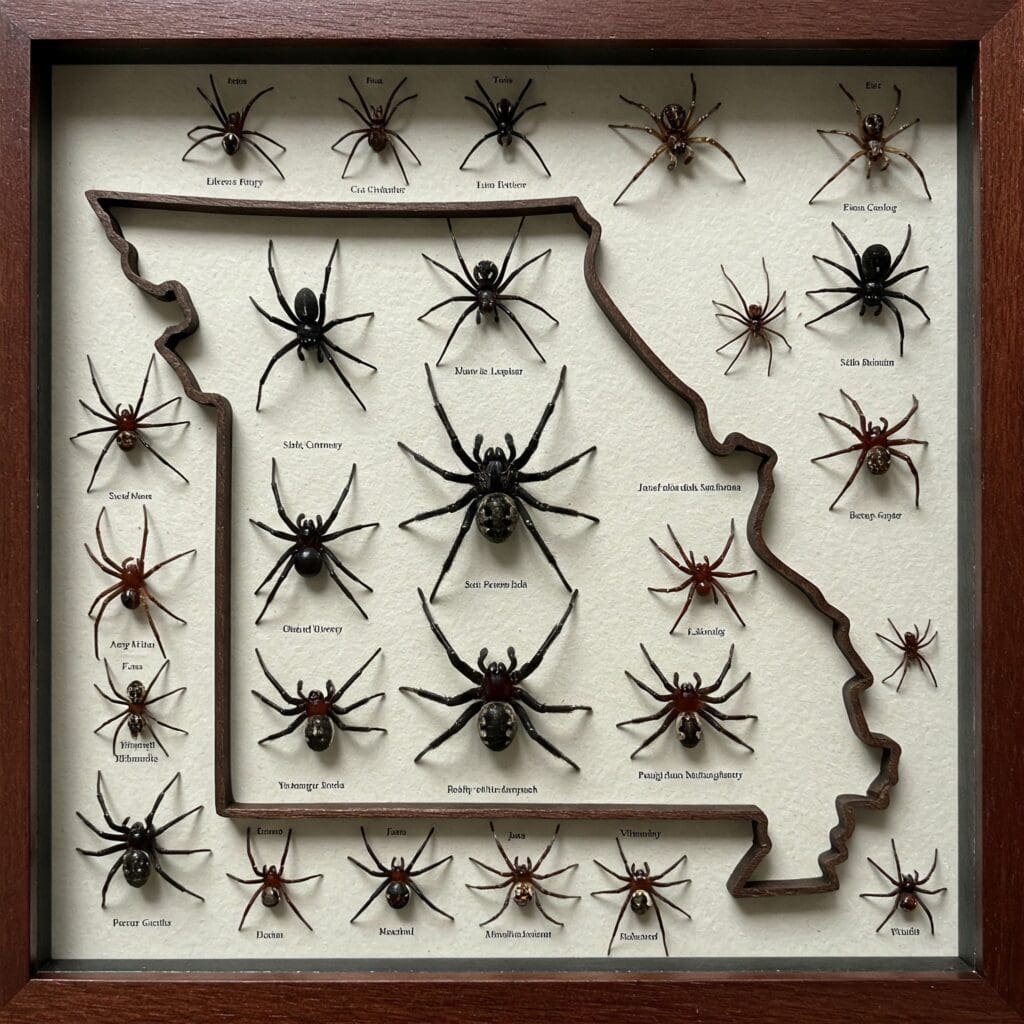Spiders of Missouri: More Than Just Creepy Crawlies in Your Kansas City Home

Have you ever been startled by spiders of Missouri or a spider web glistening in the morning light in your Kansas City garden or perhaps caught a glimpse of an eight-legged creature darting across your living room floor? For many, the initial reaction might be one of surprise, maybe even a shiver of unease. However, these often-misunderstood inhabitants of our homes and landscapes are far more than just creepy crawlies. Missouri, including our vibrant Kansas City, is home to a remarkable diversity of spiders, each playing a vital and fascinating role in the intricate web of our local ecosystem.
The sheer number of different spider species that call Missouri home is quite astounding. With over 300 distinct types identified, ranging from those no bigger than a pinhead to some boasting an impressive leg span of four inches or more, there’s a hidden world of arachnid biodiversity right under our noses. Many of these species are commonly found in urban environments like our Kansas City homes and yards. Familiar faces might include the Common House Spider, the long-legged Cellar Spider, various agile Jumping Spiders, the speedy Wolf Spiders, the colorful Garden Spider, and even the more notorious black widow and brown recluse. This blog post aims to unravel the history, explore the intriguing facts, and shed light on the unique characteristics of these often-overlooked creatures that share our state, with a special focus on the spiders you might encounter right here in Kansas City.
Spiders Through Time: A Glimpse into Missouri’s Arachnid History and Folklore
The study of spiders in Missouri has a rich history, with dedicated researchers working to understand and document the diverse species found within our borders. A significant milestone in this endeavor was the publication of “Spiders of Missouri: An Annotated Checklist” by Stirnaman and colleagues in 1998. This comprehensive work served as a historical record, meticulously cataloging spider species based on both existing scientific literature and newly collected specimens from across the state. The creation of such a detailed inventory over two decades ago underscores a long-standing scientific interest in Missouri’s arachnid fauna, highlighting the recognition of their ecological importance.
Beyond the realm of scientific study, spiders have also woven their way into the fabric of local folklore and broader mythology. Here in Missouri, in the heart of the Ozark region, an old folk belief suggests that encountering a large orbweaver directly in your path is an omen of good news – specifically, that you will soon receive a letter. This charming local tradition illustrates how spiders have been integrated into everyday superstitions, with people attributing symbolic meaning to their presence and behavior.
Looking beyond our state’s borders, the human fascination with spiders of Missouri and their intricate web-building skills stretches back to ancient times. The well-known Greek myth of Arachne, a highly skilled weaver who dared to challenge the goddess Athena to a weaving contest and was subsequently transformed into a spider, serves as a testament to this enduring intrigue. This myth reflects a deep human appreciation for the artistry and complexity of spider webs, even leading to their association with skill and creation in ancient narratives.
Japaese folklore “Jorogumo
Even further afield, in Japanese folklore, we find the tale of the Jorōgumo, a mythical creature based on a large spider capable of transforming into a beautiful woman to lure unsuspecting victims. While not specific to Missouri, this example from another culture highlights the global presence of spiders in folklore, often associated with a blend of fascination and fear, perhaps stemming from their predatory nature and sometimes unsettling appearance.
It’s also important to address some common misconceptions about spiders in Missouri. One frequent point of confusion involves the creature commonly known as a “daddy longlegs.” Despite its spider-like appearance, the daddy longlegs, or harvestman, is not a true spider at all. It lacks venom glands and fangs, and unlike spiders, it cannot produce silk. Furthermore, its body is composed of a single segment rather than the two distinct segments found in true spiders. Another myth, quite unfounded, suggests that brown recluse spiders acquired their toxicity through a mutation resulting from atomic bomb research. Such claims are entirely baseless and highlight the need for accurate information to dispel unwarranted fears surrounding these creatures.
Meet Your Neighbors: Common Spiders of Kansas City
Kansas City residents are likely to encounter a variety of spiders in Missouri species in and around their homes. Understanding their appearance, preferred habitats, and typical behaviors can help us better coexist with these eight-legged neighbors.
Common House Spider
One common spiders in Missouri is the Common House Spider (Parasteatoda tepidariorum). These spiders are relatively small, typically around 6 millimeters in body length, and are characterized by their large, bulbous abdomens. Their coloration is variable, often displaying brown, tan, and cream markings. You’ll frequently find their tangled, cobweb-like webs in the high corners of rooms, along baseboards, and in other quiet areas where insects tend to congregate. These spiders are generally not aggressive, and bites are rare and usually result in only mild irritation. They play a beneficial role by feeding on common household pests. Their preference for undisturbed corners in homes likely reflects a strategy to maximize their chances of catching prey while minimizing disruption from human activity. The fact that a single house spider can maintain multiple webs might indicate an efficient way to utilize available resources.
Cellar Spider
Another frequent inhabitant of Kansas City homes is the Cellar Spider (Pholcus phalangioides). These spiders of Missouri are easily recognized by their tiny, tan bodies and exceptionally long, slender legs. As their name suggests, they prefer damp and dark environments such as basements, cellars, and crawl spaces. They construct loose, irregular, tangled webs in corners and often hang upside down within them. While they are sometimes referred to as “daddy long legs,” it’s important to remember they are true spiders. Cellar spiders are harmless to humans, and although they possess venom and can bite, their venom is considered weak. Their preference for humid environments and their messy web structure might be adaptations for catching specific types of prey found in such conditions. When disturbed, they are known to rapidly vibrate their bodies, a unique defensive behavior that likely makes them harder for predators to target.
Jumping Spiders
Kansas City is also home to a variety of Jumping Spiders (Family Salticidae). These spiders of Missouri are small to medium in size and are easily distinguished by their remarkable jumping abilities and excellent eyesight. They are active hunters that don’t rely on webs to catch prey; instead, they stalk and pounce on unsuspecting insects. Jumping spiders come in a variety of colors and patterns, often with a furry appearance and relatively short legs.
You might spot them indoors near windows and doors or outdoors on plants, fences, and walls in sunny spots. They are generally curious and are known to approach humans, making them seem less threatening than other spiders. Their reliance on keen vision and their active hunting style represent a different ecological niche compared to their web-building relatives. Their ability to jump, sometimes up to 50 times their body length, is a significant advantage for both capturing prey and escaping danger.
Wolf Spiders
Wolf Spiders (Family Lycosidae) are another common spider in Kansas City. These are relatively large, hairy spiders that are often mistaken for tarantulas. Unlike many other spiders, wolf spiders are active hunters that roam in search of prey rather than building webs to trap it. They can be found in gardens, fields, and woodlands and sometimes venture indoors, especially at ground level. Their coloration typically consists of shades of brown, tan, black, and yellow, often with stripes or mottled markings that help them blend into their surroundings.
While their size can be intimidating, wolf spiders are generally harmless to humans, and their bites usually result in only mild irritation, similar to a bug bite. A fascinating characteristic of wolf spiders is the maternal care exhibited by females, who carry their egg sacs attached to their spinnerets and then carry the newly hatched spiderlings on their backs. This behavior highlights a unique parental strategy within the spider world.
Garden Spider
Residents with gardens in Kansas City will likely encounter the striking Garden Spider (Argiope aurantia), also known as the Black and Yellow Garden Spider. These are large orb-weaving spiders, with females being particularly noticeable due to their size and vibrant yellow and black markings on their abdomen. They construct large, intricate, wheel-shaped webs, often with a distinctive zigzag pattern of thicker silk in the center called a stabilimentum. These webs are typically built in gardens, fields, and other open areas with vegetation, serving as effective traps for flying insects. Garden spiders are beneficial for controlling garden pests and are harmless to humans, though they may bite if directly threatened. The purpose of the stabilimentum in their webs is still a subject of scientific debate, with theories suggesting it might help attract prey, deter birds from flying through the web, or even serve as a form of camouflage.
Brown Recluse Spider
The Brown Recluse (Loxosceles reclusa) is perhaps the most notorious spider in Missouri, including Kansas City. These spiders are light to dark brown and are characterized by a distinctive dark violin-shaped mark on their cephalothorax. They prefer dark, undisturbed areas such as closets, attics, basements, and under furniture. Brown recluse spiders are nocturnal and reclusive, preferring to avoid contact with humans. Bites are rare and usually occur when the spider is accidentally pressed against the skin, such as when someone rolls onto it in bed or puts on clothing where a spider is hiding. While their venom can cause necrotic lesions in some individuals, severe reactions are uncommon, and most bites heal without significant medical intervention. Despite the fear surrounding them, encounters are less frequent than often perceived due to their reclusive nature.
Black Widow Spider
“Finally, the Black Widow (Latrodectus mactans and L. variolus) is another venomous spider you can find in Missouri and Kansas City. Adult female black widows are easy to recognize by their glossy black bodies and a distinctive reddish-orange hourglass marking on the underside of their abdomen. They typically live in dark, dry, and sheltered places like woodpiles, under rocks, in sheds, garages, and other outbuildings. Black widow spiders are generally not aggressive and will only bite if they feel threatened, such as when you disturb their web or press them against your skin. Their venom is neurotoxic and can cause significant pain, muscle cramps, and other systemic symptoms, but fatalities are extremely rare, especially with medical treatment. While their venom is potent, serious incidents are uncommon.”
To help you quickly identify some of the common spiders you might encounter in Kansas City, here is a summary table:
Table 1: Common Spiders of Kansas City
| Species Name | Appearance | Common Habitat in Kansas City | Potential Risk to Humans |
|---|---|---|---|
| Common House Spider | Small, bulbous abdomen, brown/tan/cream markings | Indoors, corners, along baseboards, near ceilings | Harmless |
| Cellar Spider | Tiny body, very long, thin legs, tan color | Basements, cellars, crawl spaces, damp areas | Harmless |
| Jumping Spiders | Small to medium, stout body, short legs, excellent eyesight, various colors | Indoors near windows, outdoors on plants and walls | Harmless |
| Wolf Spiders | Large, hairy, brown/gray/tan with markings | Gardens, fields, indoors at ground level | Mild |
| Garden Spider | Large, yellow and black markings (females), large orb web | Gardens, fields, open areas with vegetation | Harmless |
| Brown Recluse | Light to dark brown, violin-shaped mark on cephalothorax | Dark, undisturbed areas indoors and outdoors | Medically Significant |
| Black Widow | Glossy black with red hourglass (females) | Dark, dry, sheltered places outdoors and indoors | Medically Significant |
Intriguing Insights: Fascinating Facts About Missouri’s Eight-Legged Residents
All spiders, including those found in Missouri, share some fundamental characteristics. They all possess eight legs and two distinct body segments: the cephalothorax (head and chest) and the abdomen. Unlike insects, they lack antennae. A defining feature of spiders is their ability to produce silk, which they do through specialized structures called spinnerets located at the rear of their abdomen. Most spiders also have eight eyes, although the number and arrangement can vary between species. Their mouthparts consist of fang-tipped jaws known as chelicerae, which they use to pierce their prey and inject venom and digestive enzymes. They also have a pair of sensory appendages called pedipalps, which function somewhat like antennae.
While all spiders have silk glands, not all use silk to build webs for catching prey. Spider silk is an incredibly versatile material. Renowned for its strength and elasticity, even surpassing steel of the same weight in tensile strength. Beyond web construction, spiders utilize silk for a variety of purposes, including wrapping captured prey, transferring sperm, lining their shelters for hibernation or molting, constructing protective egg cases, and creating draglines for safety as they move. Orb-weaving spiders, like the Garden Spider, are known for their intricate, wheel-shaped webs, which are often considered architectural marvels.
Cobweb Spiders
Cobweb spiders, such as the Common House Spider and Cellar Spider, build three-dimensional, tangled webs that are highly effective at trapping insects. Some spiders even employ more unusual techniques, like creating “web carpet” security systems with vibration-sensitive trip wires to detect passing prey. Interestingly, some orb weavers incorporate a zigzag pattern of silk, the stabilimentum, into their webs, the exact function of which is still debated by scientists.
Missouri spiders exhibit a wide array of hunting strategies. While many rely on their webs to passively capture insects that blunder into their sticky threads, others are active hunters that stalk and ambush their prey. Wolf spiders, for example, are known for their speed and agility as they chase down ground-dwelling insects. Jumping spiders, with their excellent vision, are adept at stalking and pouncing on their prey.
Even the Brown Recluse is an active hunter, venturing out from its hiding places to find food. Some spiders have even adapted to aquatic environments. Fishing spiders found in Missouri can run across the surface of the water. They can even dive beneath it to catch aquatic insects, tadpoles, and small fish. In a fascinating display of predatory behavior, some cellar spiders have been observed invading the webs of other spiders, mimicking the struggles of trapped insects to lure the host spider, which they then attack and consume.
Spider Life Cycle
The life cycle of Missouri spiders is as diverse as their appearance and behavior. Their lifespan can vary considerably, with some species living only for a year while others may survive for two or three years. Many spiders overwinter as either young spiderlings or eggs, waiting for the warmth of spring to emerge. Young spiders often disperse to new locations through a remarkable ” ballooning process. ” Where they climb to a high point, release silk threads into the air, and are carried away by the wind, sometimes traveling considerable distances. As they grow, spiders must shed their exoskeleton through a process called molting.
Female wolf spiders exhibit a strong maternal instinct. They carry their egg sacs with them until the spiderlings hatch. They also carry the young on their backs for some time. When threatened, cellar spiders have a unique defense mechanism: they rapidly vibrate their bodies, creating a blur that makes it difficult for predators to focus on them.
Missouri is even home to aquatic spiders, demonstrating their adaptability to a wide range of habitats. Fishing spiders in the genus Dolomedes are commonly found near ponds, streams, and other bodies of water. They can run across the water’s surface and even dive to hunt aquatic insects and small vertebrates. Longjawed orbweavers, another group of aquatic spiders, typically build their circular webs near the water’s edge. Perfectly positioned to catch insects that have recently emerged from the water in their winged adult forms.
Spider Eyesight
While most spiders have eight eyes, their eyesight varies. Generally, spiders are nearsighted, relying more on detecting vibrations to sense their surroundings. However, jumping spiders are an exception, possessing excellent vision that aids them in their active hunting style.
Interestingly, Missouri has its very own native tarantula species, the Texas brown tarantula (Aphonopelma hentzi). These large, furry arachnids are primarily found in the southern and central regions of the state. Despite their intimidating appearance, they are generally quite docile and pose little threat to humans. Their bite is often compared to the sting of a bee.
What’s on the Menu? Exploring the Diets of Missouri Spiders
The diet of Missouri spiders is as diverse as the spiders themselves. As predators, they primarily feed on insects and other arthropods. Orb-weaving spiders, like the Garden Spider, typically prey on flying insects such as moths and crane flies that become ensnared in their sticky webs. Wolf spiders, being ground hunters, consume a variety of ground-dwelling insects, including other spiders. Common House Spiders feed on flies, crickets, woodlice, and other small household pests. Cellar spiders have a broader diet, consuming various small arthropods, including other spiders and even crane flies, sometimes capturing prey much larger than themselves. Fishing spiders, with their semi-aquatic lifestyle, feed on aquatic insects, small tadpoles, and even tiny fish. This wide range of prey demonstrates the significant role that spiders play in controlling insect populations within our ecosystems.
The Truth About Venom: Understanding Dangerous Spiders in Missouri
While all spiders possess venom. The vast majority of species in Missouri are harmless to humans. Their bites typically cause only minor and temporary irritation. However, there are two native spider species in Missouri that are considered medically significant. The Brown Recluse and the Black Widow.
The Brown Recluse is identified by its light to dark brown color and the distinctive violin-shaped marking on its cephalothorax. They prefer dark, undisturbed areas. Their venom is necrotic. This means it can cause tissue damage. Thus potentially leading to the formation of a lesion or ulcer at the bite site. However, it’s important to remember that brown recluse spiders are not aggressive and bites are relatively rare, often occurring when the spider is trapped against the skin. Severe reactions are uncommon, and most bites heal without serious complications.
The Black Widow is easily recognized by its glossy black body and the characteristic red hourglass marking on the underside of the female’s abdomen. They are typically found in dark, dry, and sheltered locations. Their venom is neurotoxic, affecting the nervous system and potentially causing muscle pain, cramps, and other systemic symptoms. Bites usually occur when the spider feels threatened. While the venom is potent, fatalities from black widow bites in North America are extremely rare, especially with medical attention.
Minimize Risk of Bites
To minimize the risk of bites from these venomous spiders, it’s advisable to take some simple precautions. Avoid areas where these spiders are known to concentrate, such as woodpiles and cluttered storage spaces. Keep living spaces clean and free of clutter, especially in areas like closets, basements, and unused rooms. Shake out clothing, shoes, and bedding before use. Particularly if they have been stored in areas where spiders might be present.
Be cautious when reaching into dark or undisturbed places. Importantly, look in lumber piles, window wells, under rocks, or in seldom-used cabinets and drawers. If you suspect you have been bitten by a brown recluse or black widow. Seek medical attention promptly. Despite the potential for a serious bite from these two species. It’s important to remember that serious injuries or fatalities from spider bites in Missouri are extremely rare. The vast majority of spiders in our state are harmless and play a beneficial role in our environment.
Spiders and Our Ecosystem: Their Important Role
Spiders, including those in Missouri and Kansas City, play a crucial role in maintaining the balance of our ecosystems. As predators, they are highly effective at controlling populations of insects. Also, other arthropods, many of which can be considered pests that harm crops, gardens, and even spread diseases. In fact, it has been estimated that spiders consume an enormous quantity of insects each year. Thus playing a vital role in regulating these populations. Furthermore, spiders themselves serve as an important food source for a variety of other animals, including birds, bats, and other insectivores. Their presence contributes to the overall health and stability of our local environments.
Conclusion: Appreciating the Unseen Majority
The world of spiders in Missouri is a diverse and fascinating one. Far exceeding the common perception of them as merely creepy crawlies. From our basements’ tiny inhabitants to our gardens’ colorful guardians. These eight-legged creatures play a vital role in our local ecosystem, primarily by helping to keep insect populations in check. While the Brown Recluse and Black Widow rightfully command a degree of caution. It is important to remember that serious incidents are rare. The vast majority of the over 300 spider species in our state are harmless and even beneficial.
So the next time you encounter a spider in your Kansas City home or garden. Take a moment to observe it with curiosity rather than fear. By understanding their fascinating behaviors and important place in the web of life, we can gain a new appreciation for these often unseen neighbors who share our world.

Jeffery Preece, BCE, PHE
Jeffery Preece is the owner/technical director of ZipZap Termite & Pest Control.



